Does Yoga Help In Reducing Anxiety? – Know These 12 Best Yoga Poses For Anxiety
Are you someone who suffers from anxiety and panic attacks? You are not alone. There are several others out there who feel embarrassed for the temporary chaos that anxiety causes to their behavior. Schedule a time for practicing these 12 yoga poses for anxiety & get ready to witness an amazing change in your personality.
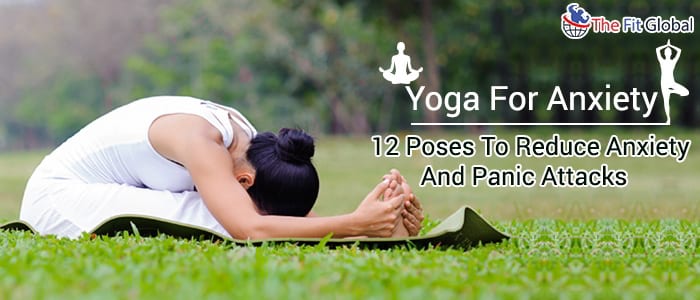
Table of Contents
How Does Anxiety Feel Like?
Panic Attack Symptoms
Normal Anxiety Symptoms
Types of Anxiety
Can Yoga Help With Anxiety?
12 Best Yoga Poses For Anxiety
Life Through The Eyes Of A Person Suffering From Anxiety!
How do you feel when you are about to take that big life-changing test or how do you feel when asked to speak in front of a huge audience? Well, we all carry a little bit of fear inside us that changes our behavior during such situations.
Sadly, people suffering from anxiety disorders feel this nervousness all the time. However, there are certain yoga poses for anxiety that have been suggested to help people get over frequent panic attacks and general anxiety symptoms.
Just ensure that you firmly stick on to your workout schedule and be committed until you witness a change in your behavior.
[ Also Find: How To Alleviate Depression Naturally ]
How Does A Person Feel During A Panic Attack?
Sometimes the situation may get worse, they experience panic attacks during which they feel symptoms like
- Tightness in their chest
- Their heartbeat becomes irregular
- They suffer from shortness of breath
- Feel a sensation of choking
- They may feel detached from their own self or reality
- They start sweating profusely.
This is only the case during panic attacks.
[ Find More: How To Get A Powerful Respiratory Health ]
How Do People Suffering From Anxiety Feel When They Are Normal?
The symptoms are different when such people are normal. Here is how they feel all the time.
- They suffer from restlessness
- Fatigue
- Laziness and lethargy all the time
- Difficulty in concentrating
- Sleepless nights
- Being vulnerable all the time
- General weakness and
- Other digestive disorders such as constipation, excessive bloating, or diarrhea.
Types Of Anxiety
Based on how people feel during various situations, anxiety has been categorized into four different types.
1. Panic Disorders Or Anxiety Panic Attacks
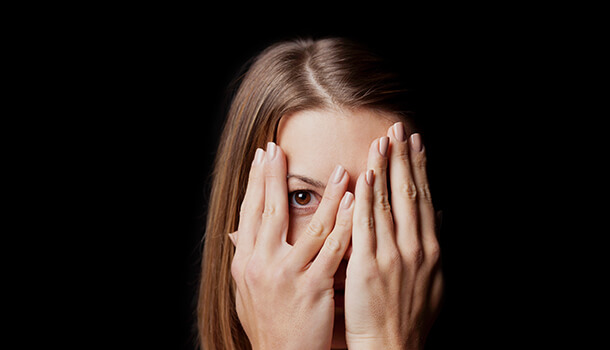
Not all people suffering from anxiety do suffer from panic attacks. When the situation becomes extreme, panic attacks become a frequent aspect of a person’s life.
It is during such situations that people feel disconnected from reality for a temporary period, experience a sudden change in the heartbeat, discomfort in the chest, a feeling that may feel like you are experiencing a heart attack and excessive sweating.
2. Phobias Which Are Specific
We all fear something in our lives. Water, heights, dogs, crowded places and the list goes on. We all fear something in particular. For example, you may feel a type of nervousness or anxiety when you are at the top of the building and you suffer from acrophobia (fear of heights).
Sometimes, the fear might get so intense, you may start avoiding the situation even though it does not involve a long height.
3. Social Anxiety
People suffering from social anxiety worry about how they might appear in other people’s eyes. They might constantly feel worried that they might get rejected by others or that their performance could be negatively evaluated.
This makes them avoid normal situations which involve social interactions because they feel vulnerable that they might get humiliated or embarrassed in front of others.
If you are someone suffering from social anxiety, calm down because it is not a big deal! The anxiety that you have been facing is only because of your overthinking.
You just have to understand that other’s opinions and judgement do not matter much as long as you are happy and contented with your own self.
#Tip –Get into the journey of self-discovery and become self-confident enough to an extent that you feel other’s judgement is not what you are living for.
4. General Anxiety
Those who suffer from general anxiety do not need any reason to feel anxious or nervous. They tend to feel worried in all kinds of situations.
They might feel anxious about certain situations that might have disturbed their mindset in the past, or they could be worrying that something might not go well in the future.
Can Yoga Help With Anxiety?
Although there are many forms of workouts that help in the overall well-being of our health, there is a lot of importance given to Yoga for anxiety relief!
Basically, any form of exercise can relieve you from stress, but no art form works in improvising the three major dimensions of your life which are physical, mental and spiritual aspects.
This ancient art form involves various forms of postures that help in the deep relaxation of your cranial nerves so that you do not feel anxious or tensed throughout the day.
There are various forms of breathing exercises that help you in relieving from physical symptoms that are caused due to anxiety.
12 Best Yoga Poses For Anxiety – The Best Natural Treatment For Anxiety
To enjoy the best benefits out of these yoga poses for anxiety, make some time for yourself early in the morning to get close to nature and stretch yourself to obtain a deep relaxation.
1. Big Toe Pose Or Padangusthasana
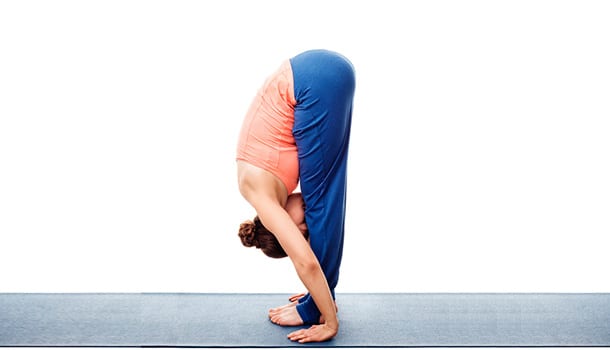
Big toe pose, also known as padangusthasana, can be broken down as Pada which means foot, angustha which means big toe and asana meaning posture in the Sanskrit language.
HOW TO PERFORM BIG TOE POSE?
- Stand straight with both your hands placed at the sides
- Maintain a distance between your feet, the distance which should be equal to your hip width
- Bend forward (without bending your knees) and try to grab your toe fingers with the help of the thumbs of both your hands.
- Make sure that you do not bend your knees while performing the exercise.
- Try to touch your knees with the help of your forehead and remain in the position for 5-10 seconds.
- Release your fingers from the toes and slowly get back to the normal position.
HOW DOES BIG TOE POSE HELP ANXIETY?
Practicing this pose on a regular basis helps in solving the trouble of insomnia as it helps in relieving you from stress, thereby providing a calming effect to your brain.
The pose can help in relieving you from any kind of stomach disorders like constipation, bloating or diarrhea.
2. Bow Pose Or Dhanurasana
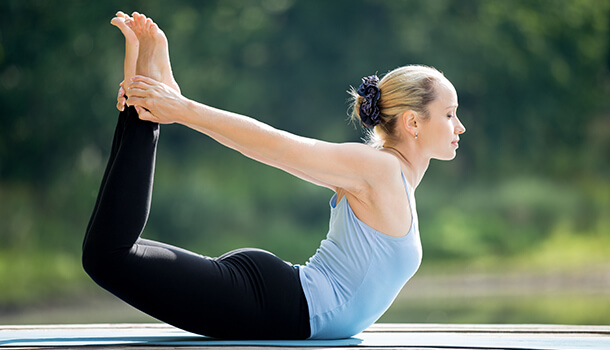
Bow pose which is one of the most effective yoga poses for anxiety has been derived from the Sanskrit word “Dhanurasana” which can be split down into dhanu meaning bow and asana meaning pose.
HOW TO PERFORM THE BOW POSE?
- Lie down on the floor (the side of your stomach facing the floor) and maintain a distance of hip width between your feet. Place your arms on either side of your body.
- Bend your knees and extend your hands back to hold your ankles with the help of your hands.
- Take in a deep breath and raise the upper part of your body (chest) and legs off the ground.
- Ensure that you form the shape of a bow as you maintain the pose.
- Stay in the position for at least half a minute and slowly exhale while getting back to the normal position.
HOW DOES BOW POSE HELP ANXIETY?
A bow pose helps in stretching your body to the maximum extent and you will be able to experience a deep sense of relaxation as you inhale and exhale while performing the pose.
You will see a gradual reduction in your anxiety when you make dhanurasana a daily aspect of your life.
Note- Avoid practicing the pose if you have been suffering from any serious spinal cord problems or serious stomach disorders.
3. Camel Pose Or Ustrasana
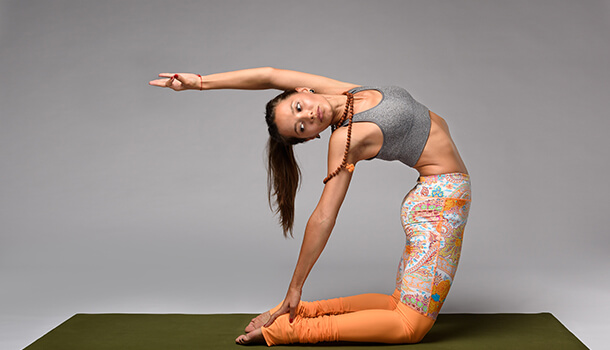
Camel pose also known as Ustrasana where ustra means camel and asana meaning pose. The pose is said to be highly beneficial for those who are suffering from thyroid disorders since it helps in stretching your thorax region to the maximum extent.
HOW TO PERFORM CAMEL POSE?
- Kneel down on the floor such that your knees and shoulders are in the same vertical line.
- The soles of your feet should be facing the ceiling as you kneel down
- Extend your hands backwards and grab your ankles with the help of your palms
- You must be able to feel a pull at your navel as you stay in the position.
- Stay in the position for 30 seconds before you get back to the normal position.
HOW DOES CAMEL POSE HELP ANXIETY?
Camel pose is one of the best poses of yoga for anxiety disorder because staying in the pose for at least 30 seconds helps in an effective circulation of blood throughout your body, more particularly helping in an effective supply of oxygen to the brain.
This relieves you from the symptoms of anxiety such as nervousness and tension.
4. Bridge Pose Or Sethu Bandhasana
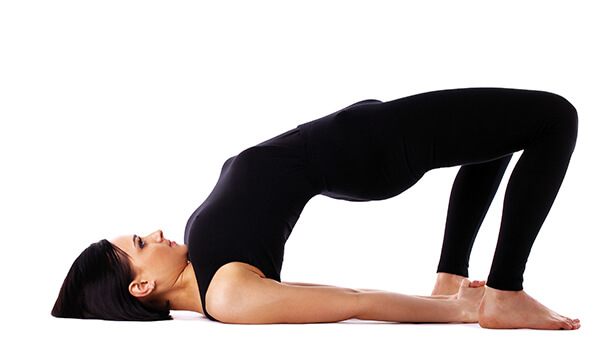
The pose is also known as Sethu bandhasana where Sethu means bridge and bandha means to lock in the Sanskrit language. The pose majorly helps in strengthening the back muscles and muscles in the neck region but is also the best-recommended pose of yoga for natural anxiety relief.
HOW TO PERFORM THE BRIDGE POSE?
- Lie down on the floor with your back facing the floor. Place your feet 6 inches apart from each other making sure that your ankles and knees align in the same vertical line.
- Rest your hands on the floor (hands placed on either side of the body) with your palms facing the floor.
- Raise your body off the floor such that your upper part of the back, middle part and lower portion of your back are off the ground.
- Puff up the chest which helps lift the feet.
- Raise your back as high as you can and stay in the position for about 30 seconds before you get back to the normal position.
HOW DOES A BRIDGE POSE HELP ANXIETY?
As you stay in the bridge pose, your body gets stretched to the best possible extent and there is a good blood circulation provided throughout the body which calms your mind and cures any sort of tension or anxiety.
5. Cat-Cow Pose For Natural Anxiety Relief
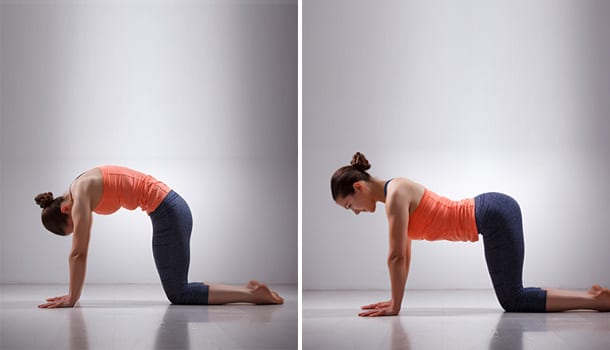
Cat pose which is commonly called as Marjariasana has a Sanskrit meaning behind its name which implies to marjari means cat and asana means pose.
Cow pose is known by the name Bitilasana where bitila means cow and asana means pose. Since the exercise requires you to get into two different poses (a cat while exhaling and a cow while inhaling), it is known as cat cow pose.
Apart from being the best posture of Yoga for anxiety disorder, it helps in providing relief from spinal problems and injuries.
HOW TO PERFORM CAT COW POSE?
- Get on to your two hands and two feet like that of a cat
- Adjust your gaze between your hands.
- Take a deep breath (inhalation) and push your head backwards such that you are gazing at the rooftop. Now you are in a cow pose.
- Make a gradual exhalation and come into the cat pose by tilting your head downwards such that your chin touches your chest.
HOW DOES CAT COW POSE HELP ANXIETY?
You are making deep inhalations and gradual exhalations and stretching your spine as if you are relaxing both your mind and your body which makes it one of the best poses of yoga for anxiety disorder.
[ Also Read: How Yoga Helps in Fighting A Thyroid Disorder ]
6. Fish Pose Or Matsyasana
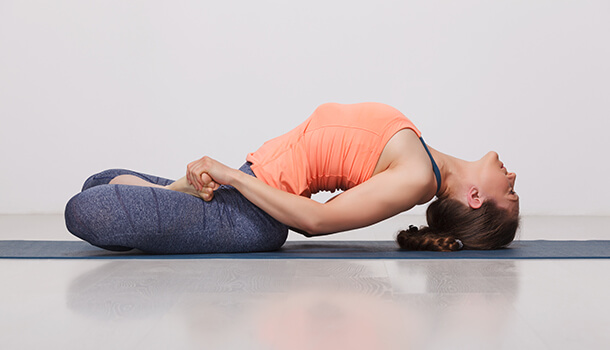
The term fish pose implies to Matsyasana where Matsya means fish and asana means pose. The pose not only works the best as the natural treatment for anxiety but it also helps people suffering from spinal problems.
HOW TO PERFORM FISH POSE?
- Lie down on the floor such that your back is facing the floor.
- Place your hands on either side of your body.
- Raise your shoulders and along with the upper part of your body with your head still in contact with the floor.
- Start tilting your head backwards such that the top part of your skull comes in contact with the floor.
- Stay in the position for 10-15 seconds and be careful while getting back to the normal position.
HOW FISH POSE HELPS ANXIETY?
The pose essentially helps in providing your brain with enough amounts of oxygen which relieve you from the confusion and chaos caused due to anxiety.
The fish pose also helps in providing strength to the spine and neck muscles.
7. Corpse Pose Or Shavasana
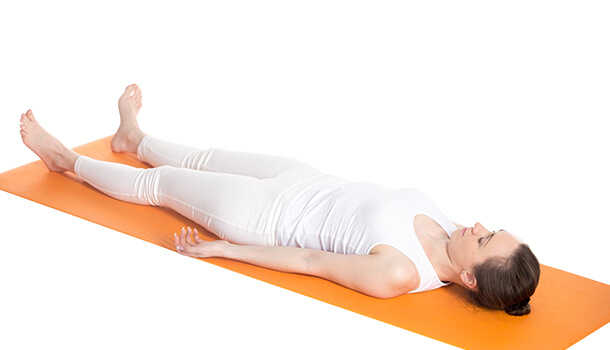
One of the best yoga poses for anxiety that provides a great relief from tension and stress is a corpse pose. Ironically, most people get drifted away into a good sleep while practicing the pose which makes it their favorite pose.
The purpose altogether is the same (providing relaxation) but falling asleep while doing a corpse pose(1) is a wrong way of doing the pose.
HOW TO DO A CORPSE POSE?
- Lie down on the floor with your legs placed hip-width apart from each other.
- Extend your arms towards the sides of your body such that your palms face the roof.
- Take deep inhalations and gradual exhalations and shift your focus from one part of the body to another (starting from toes till the head) observing the activities taking place in each part of the body while practicing breathing.
- Stay in the position for a maximum of 3-4 minutes.
HOW CORPSE POSE HELPS ANXIETY?
The pose helps in deep relaxation of muscles and provides a calming effect to the brain. Also, corpse pose helps in improving the concentration power making the person mindful of the current situation, Thereby Reducing the Chance Of Panic Attacks.
8. Seated Forward Bend Or Paschimottanasana
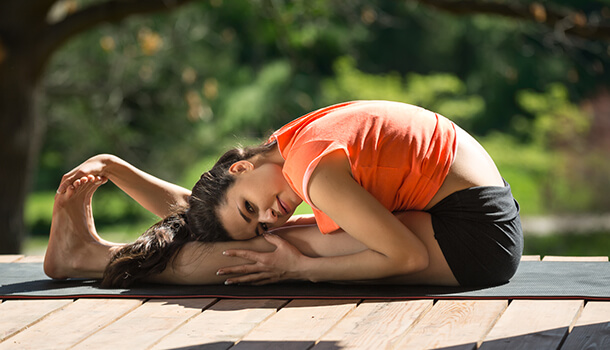
The pose is also commonly known as paschimottanasana in Sanskrit which can be split down as paschima meaning west and utthana meaning an immense stretch.
HOW TO DO A CORPSE POSE?
- Sit down on the floor, with your legs extended forward
- Make a deep inhalation while raising your hands and hold your breath
- Bend forward such that your hands reach your toes and try holding your toes with both your hands (Exhale while bending forward)
- Try to touch your knees with your forehead as you bend
- Stay in the position for 10 seconds after which you can get back to the normal position.
HOW SEATED BEND FORWARD HELPS ANXIETY?
The stretching helps in relaxation of your muscles and improvises the blood circulation throughout your body which is why it is considered as one of the most effective yoga poses for anxiety.
9. Child’s Pose Or Balasana
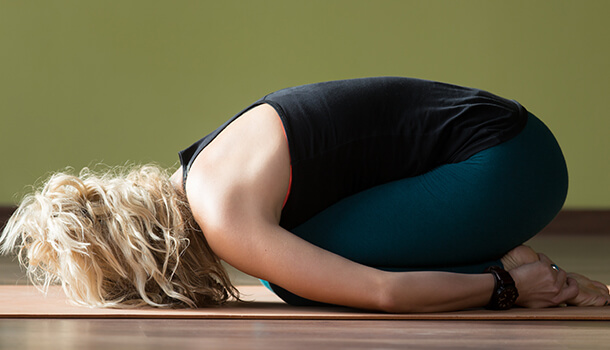
The word child’s pose is derived from the word Balasana where bala means child and asana means pose. The pose has been named such because it makes you relaxed and playful just as a child.
HOW TO DO A CHILD’S POSE?
- Start by kneeling down on the floor and sit down by resting your buttocks on your ankles.
- Maintain a distance of six inches between your knees.
- Make a deep inhalation while raising your hands and bend forward to place your hands on the floor.
- Your chest should come in contact with your thighs as you bend and your forehead should touch the floor.
- Remain in the position for 20 seconds and make a gradual exhalation while coming back to the normal position.
WHY IS CHILD’S POSE IS THE BEST POSE OF YOGA FOR ANXIETY DISORDER?
As the term itself suggests, you get into a quite playful mood as you practice the pose and moreover the pose helps you to stretch your body and improve circulation throughout your body.
10. Legs Up The Wall Or Viparitha Karani
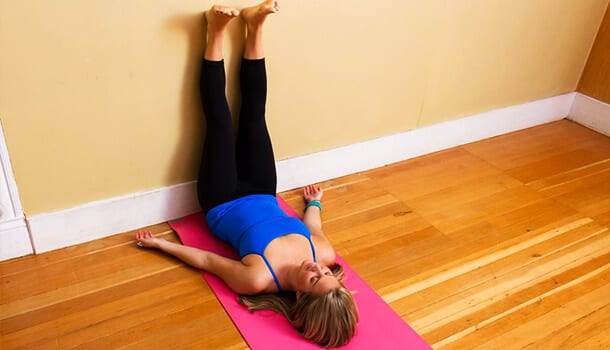
You may sometimes get into this pose unconsciously while reading your favorite novel or while playing your favorite game but scientifically, the pose helps you in improving the circulation of blood throughout your body and reducing your stress levels.
The pose is also known as Viparitha Karani in Sanskrit which literally translates to upside down.
HOW TO PERFORM THE POSE?
- Choose a place at your home that is closer to the wall
- Lie down on the floor and move your legs closer towards the wall.
- Raise your legs upward and rest them on the wall, with the wall being the support for your legs.
- Place a folded blanket under the hips for comfort and to maintain a natural curve in the lumbar spine.
HOW THE POSE HELPS ANXIETY?
Getting into Viparita Karani pose makes the blood flow freely from your toes to your head enabling a better supply of oxygen to your nervous system.
This keeps you refreshed throughout the day and helps you focus better reducing the symptoms of anxiety.
[ Find Out: Fight Ovarian Cyst with the Help of Yoga ]
11. Extended Triangle Pose Or Trikonasana
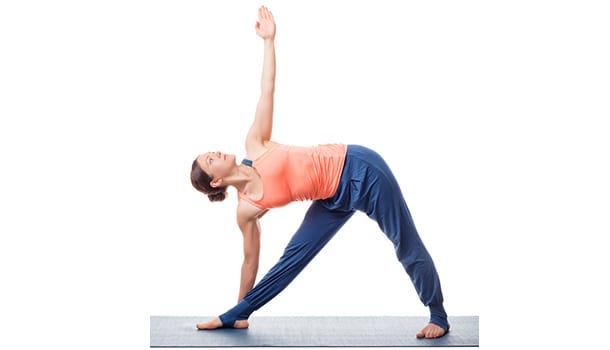
The pose is also known as Trikonasana which means a triangle in the Sanskrit language since it appears in that shape.
HOW TO PERFORM?
- Stand straight with your hands placed on either side of your body.
- Maintain a distance of approximately 3 feet between your feet.
- Bend your body towards the right side and try to touch your right toe with the forefingers of your right hand.
- Raise your left hand vertically up into the air as you bend towards your right side.
- Adjust your gaze towards your left hand as you remain in the position.
- Get back to normal position and repeat the same with your left hand.
HOW THE POSE HELPS ANXIETY?
The pose helps you in improving the blood circulation and provides a good stretch to your body. It can also help in improving your concentration and helps you stay mindful.
12. Anjali Mudra
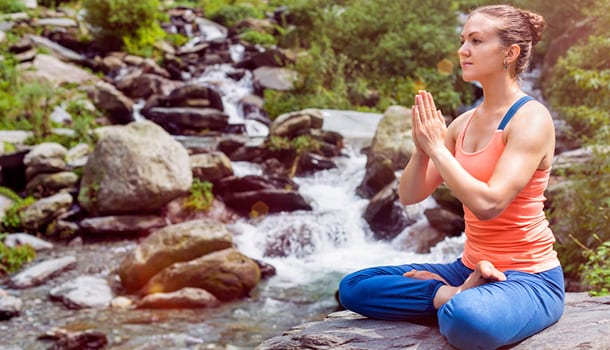
One of the best yoga poses for anxiety that makes your mind peaceful is Anjali Mudhra. It is one of the best meditation practice which you can make a daily aspect of your life.
HOW TO PERFORM ANJALI MUDHRA?
- Find a peaceful place that is devoid of all the distractions.
- Sit down cross-legged and join your hands together.
- Bring your joined hands closer to your chest and close your eyes
- Try to focus the mind and start observing the activities taking place in various parts of the body right from your toes to the head.
- Try avoiding distractions and be patient enough to bring your mind to the focus.
- You may require time to make yourself mindful but it is worth trying because you will feel a sense of deep relaxation once you achieve the power of being mindful.
[ Also Read: Understanding Yoga On the Whole ]
How Anjali Mudhra Helps Anxiety?
To practice, Anjali Mudhra is nothing but to mediate which helps you stay away from frequent panic attacks caused due to the chaos created inside your mind.

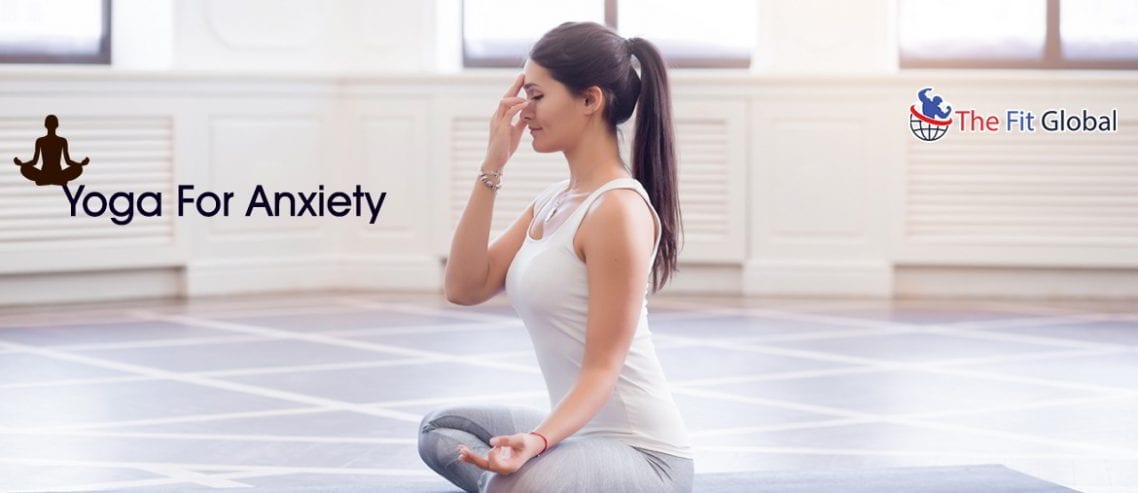
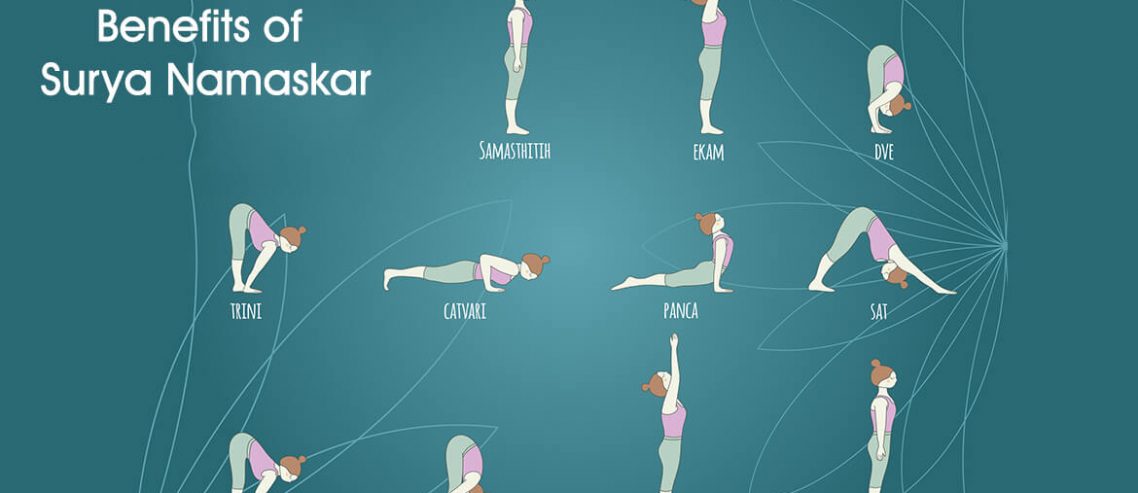
Comments
Leave a Comment